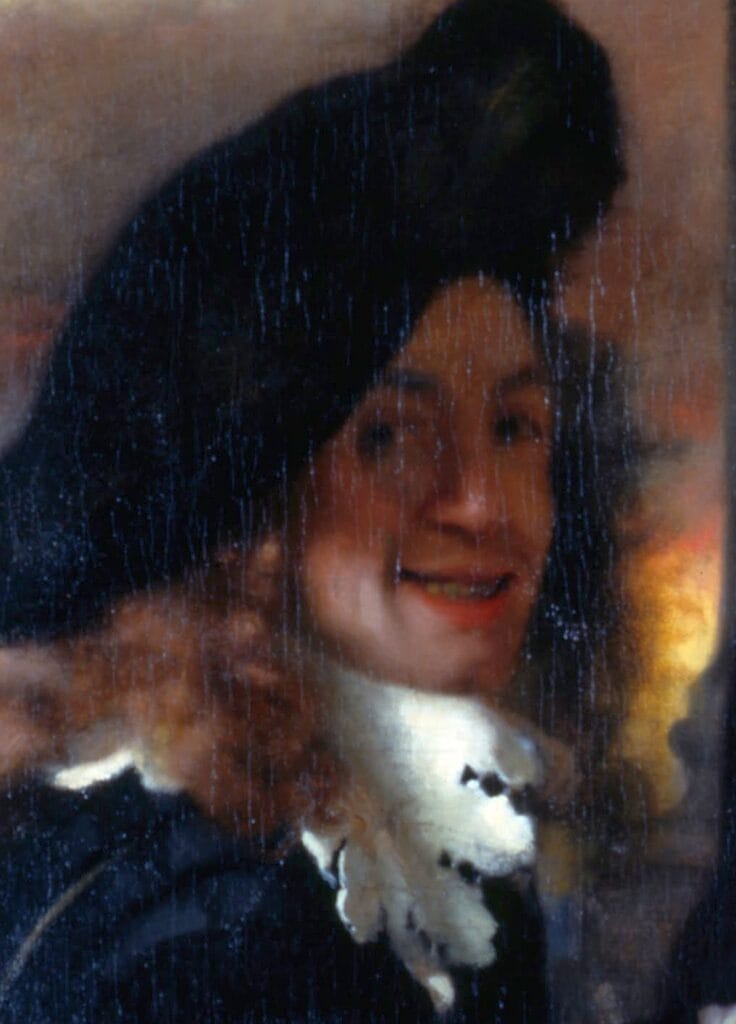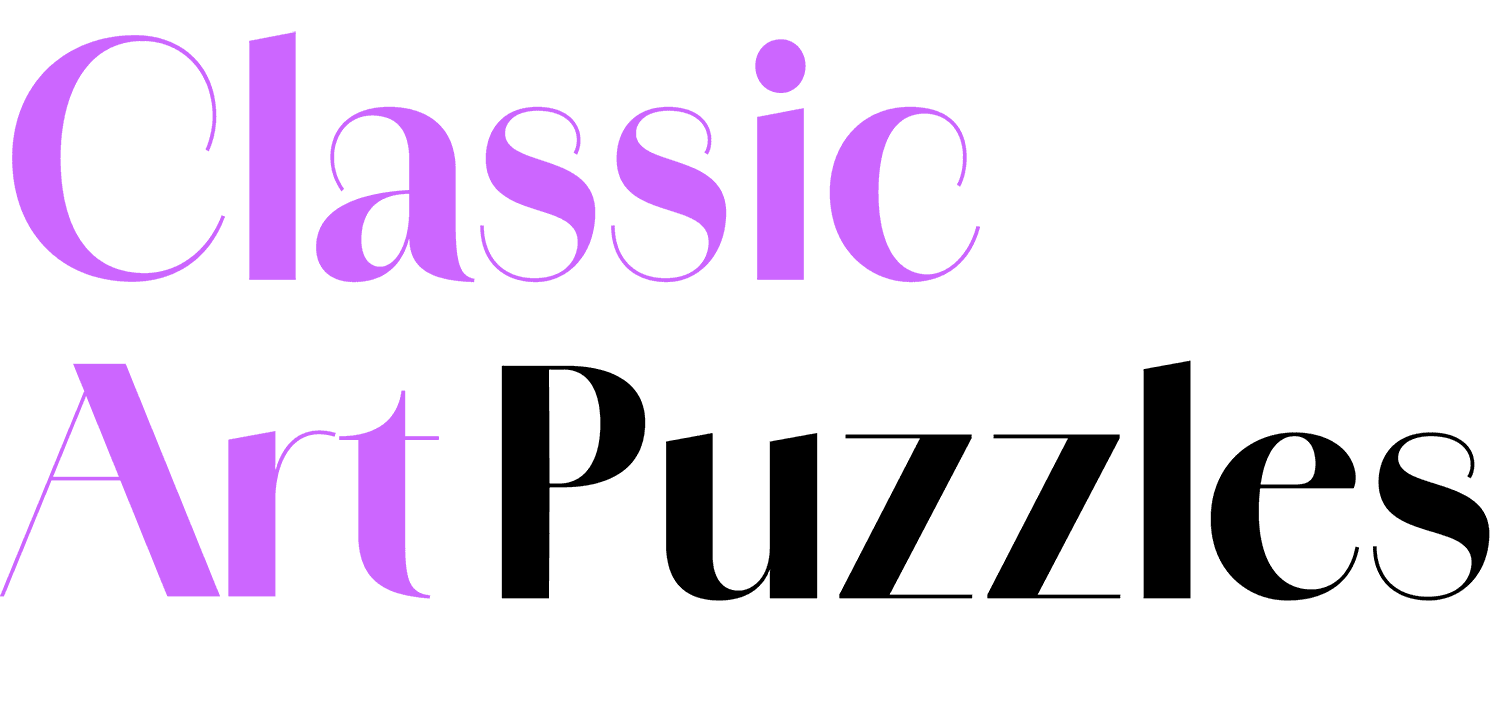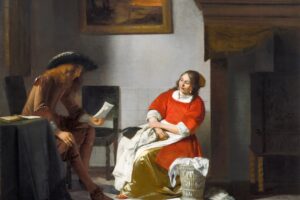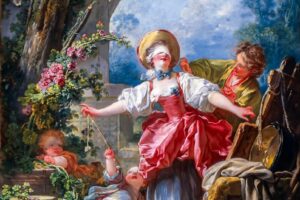The Art of Painting
Johannes Vermeer, c. 1666–1668 – Baroque Intimacy in a Studio of Light
In The Art of Painting, Vermeer turns inward. While Baroque art often dazzles with drama and grandeur, this painting offers quiet reverence. Created in Delft during the late Dutch Golden Age, it is both a self-reflection and a meditation on what it means to create. The artist is seen from behind, brush in hand. The model before him, dressed as Clio, the muse of history, poses beneath a golden chandelier and in front of an elaborate map. This is not merely a scene—it is a statement.
The Scene Before Us
The viewer peers into a studio, as if through parted curtains. A painter sits at work, capturing the image of a woman holding a trumpet and book—symbols of fame and the written word. She stands with poise, illuminated by a soft and perfect light. The black-and-white tiled floor leads the eye inward. Books, fabrics, a chair, and a plaster mask rest quietly, each object carefully chosen. A sense of hushed concentration pervades the room, where light does not fall by chance but guides our attention with purpose.
The Deeper Meaning
This is a painting about painting, but also about legacy. Vermeer’s artist paints Clio, the muse of history, suggesting that painting—like poetry or chronicles—has the power to preserve memory and truth. The large map on the wall evokes both geography and the spread of knowledge, while the chandelier above, unlit, reminds us that the true illumination here is not from fire, but from vision. The artist’s back is to us, his identity obscured. It is not who he is, but what he does that matters.
A Moment Caught in Time
Everything in this space is stilled and suspended—timeless. The painter is frozen mid-stroke. The model gazes quietly forward. We sense no urgency, only devotion. The floor gleams. The folds of the curtain feel freshly moved. Yet this is not documentary—it is idealized, staged, elevated. Vermeer has lifted the humble act of painting into something sacred. Through technique so subtle it vanishes into light, he has told a story of art’s endurance. It is as if we are witnessing the birth of memory itself.
About Artist

Johannes Vermeer (1632–1675), a Dutch painter from the city of Delft, is widely regarded as one of the most masterful painters of the Dutch Golden Age. Unlike contemporaries who were prolific and traveled widely, Vermeer lived a relatively quiet life, producing a small but exquisite body of work—only about 36 paintings survive—that has earned him the title “The Sphinx of Delft” due to the mystery surrounding his life and techniques.
Mastery of Light and Atmosphere
Vermeer’s genius lies in his unparalleled ability to capture the subtle effects of light. His paintings are not simply illuminated; they feel as though they are filled with a serene, pearlescent light. He often depicted a single window on the left side of the canvas as the primary light source, creating a soft, diffused glow that gives his interiors a sense of peace and intimacy. This technique, a departure from the dramatic tenebrism of Caravaggio, allows him to meticulously render the textures of objects, the folds of fabric, and the gentle shadows on a person’s face.
Subject and Style
While he began his career with large-scale biblical and mythological scenes, Vermeer is best known for his genre paintings—depictions of everyday domestic life. His subjects are often women absorbed in quiet, contemplative activities: reading a letter, playing a musical instrument, or pouring milk. These seemingly simple moments are imbued with a sense of quiet dignity and psychological depth. His paintings are not overtly narrative; instead, they invite the viewer to contemplate a single, suspended moment in time.
Technical Innovations and “The Camera Obscura”
Vermeer’s extraordinary realism and his signature “circles of confusion”—small, blurred highlights on shiny surfaces—have led many art historians to speculate that he used a camera obscura, a precursor to the modern camera. This device projects an image from an outside scene onto a surface inside a dark room. While he likely did not trace the images directly, the use of such an optical tool would have helped him understand and render the effects of light, perspective, and depth of field with an almost photographic precision.
Notable Works
Vermeer’s small oeuvre includes some of the most beloved paintings in art history:
- Girl with a Pearl Earring: A captivating “tronie” (a study of a face) that, through its striking use of light and the subject’s enigmatic expression, has become one of the most famous paintings in the world.
- The Milkmaid: Celebrated for its remarkable rendering of light and texture, this painting transforms a simple domestic chore into a monument of quiet strength and beauty.
- View of Delft: One of only two surviving landscapes by the artist, this painting is a masterpiece of Dutch Realism, capturing the city’s atmosphere with an incredible sense of scale and detail.
- The Art of Painting: An allegorical work that many consider to be Vermeer’s most significant. It shows a painter at his easel (believed to be Vermeer himself) in the act of creation, a profound statement on the value and importance of art.
Vermeer’s influence has grown immensely since his rediscovery in the 19th century. His meticulous technique, profound sense of stillness, and ability to elevate the mundane to the magnificent continue to captivate audiences worldwide.



